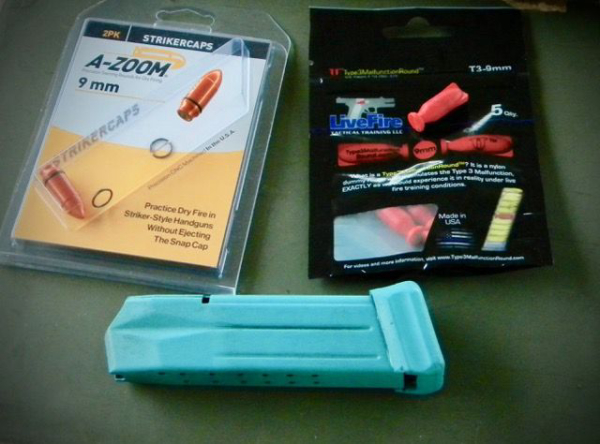
We all know how important practice is. This is when you’re actually learning the necessary skills for defense. There’s no better way to learn how to manipulate your weapon than dry-practice; repetition, repetition and more repetition. Considering today’s ammo concerns, dry-practice makes even more sense. Here are a few tools that will help ensure a healthy return on your time spent dry-practicing.
Nobody here should need an introduction to Lyman company. They offer an assortment of shooting products. Their A-Zoom ‘StrikerCaps’ are a great way to work on trigger control. When using a traditional snap cap, which is a copy of the exact round, every time you cycle the slide the cap is ejected. They get lost. You miss one or two laying on the ground, or they slip into a nook or cranny where you can’t get to them, especially inside your home.
The ‘StrikerCaps’ are made to absorb energy from the firing pin, like traditional snap caps, but don’t have a rim for the extractor to hook on for ejection. An O-ring keeps the cap located in the chamber. You press the trigger and get a click. This is followed by a “tap, rack and assess.” Press again and repeat. The StikerCap stays in the chamber until you’re finished – there’s nothing to hunt or lose. Then, lock the slide to the rear and use a small dowel or rod to push the StrikerCap out the rear of the chamber.
Type III malfunctions are the worst stoppage you can have with the semi-auto pistol. Yes, you can clear the pistol and get it operational again, as opposed to a jam or breakage, which require time and tools to correct. The sequence to clear the dreaded Type III is to unload. Remove the mag, cycle the slide three times to clear out the trash and then reload.
The problem is setting up the Type III to practice. You had to unload, lock the slide to the rear and drop an empty case into the chamber. Then, insert the mag – loaded with dummy ammo for dry-practice or live rounds for live-fire - and release the slide. Now, you have a Type III -- but you know it’s coming. The ‘Type3MalfunctionRound’ from LiveFire Tactical Training, LLC solves this problem. This is a training round you can put into the mag with live ammo or dummy rounds. At some point as you’re firing - or cycling through the standard dummy rounds and clearing Type I stoppages - the ‘Type3MalfunctionRound’ attempts to load into the chamber, but it can’t due to the fins on the front of the round. Now, it’s time to clear the Type III stoppage. This is an excellent training tool.
The final tool is simple. Take an old magazine and simply remove the guts. Now you have the mag or baseplate to “tap” during your practice. It’s more realistic, plus you can cycle the slide repeatedly without it locking to the rear like it would if the magazine had the spring and follower in it. Any mags that are modified should be painted an obnoxious color to ensure there is no chance of confusing them with real magazines.
Live fire practice has gotten expensive. In my classes I’ve cut way down on the amount of live-fire compared to dry-practice. (Students are actually learning more this way, too.) The more dry-practice you perform the more productive the live fire work, and again it cuts way down on expenses. Think about your trips to the range as a test – you’re firing very few rounds. The dry-practice is the homework, to prepare you for the test, or the ultimate exam on the street.
Tiger McKee is director of Shootrite Firearms Academy. He is the author of The Book of Two Guns, AR-15 Skills and Drills, has a regular column in American Handgunner and makes some cool knives and custom revolvers. Visit Shootrite’s Facebook page for other details.